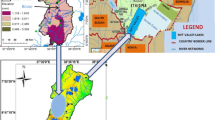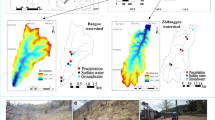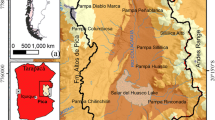Abstract
The correct management of groundwater depends on information regarding the evolutionary processes of groundwater and the characterization of spatial variability of recharge mechanisms. GIS-based index models have become a reliable alternative for map** and interpreting recharge models due to their adaptability and reliability in estimating recharge. Furthermore, stable isotopes of hydrogen and oxygen in water (δ2H and δ18O) help determine the origin and monitoring of water in the hydrological cycle. This paper aims to contribute to the knowledge of groundwater recharge by develo** a conceptual recharge model using stable isotopes and estimating the recharge amount using a spatially distributed water balance model based on GIS for the Zamora River Basin (ZRB) in Ecuadorian Amazon. Due to the basin's size and geography, it was necessary to divide it into six precipitation blocks. The high precipitation rates resulted in high (18.22%) and moderate (30.93%) recharge zones across the basin. The analysis of stable isotopes in water indicates that precipitation water comes from the east, from the Amazon plain. In the valleys, precipitation enriched in δ18O suggests that it has undergone a recycling process in the basin; groundwater recharge comes from these precipitations. This analysis provides a simplified representation of reality that can assist in predicting the impacts of human activities on the basin.










Similar content being viewed by others
Data availability
The data generated and analyzed are shown in this manuscript. Details of how the data were obtained and processed are given in the methodology section. Data sets generated during the current study are available from the corresponding author upon reasonable request.
References
Allison GB (1988) A review of some of the physical, chemical and isotopic techniques available for estimating groundwater recharge. Estimation of natural groundwater recharge. Springer, Cham, pp 49–72. https://doi.org/10.1007/978-94-015-7780-9_4
Andreo B, Vías J, Durán JJ, Jiménez P, López-Geta JA, Carrasco F (2008) Methodology for groundwater recharge assessment in carbonate aquifers: application to pilot sites in southern Spain. Hydrogeol J 16(5):911–925. https://doi.org/10.1007/s10040-008-0274-5
ASCE-American Society of Civil Engineers (1969) Effect of urban development on flood discharges. Current knowledge and future needs. J Hydraul Div 95(1):287–309
Avcı D, Fernández-Salvador C (2016) Territorial dynamics and local resistance: two mining conflicts in Ecuador compared. Extr Ind Soc 3(4):912–921. https://doi.org/10.1016/j.exis.2016.10.007
Blasch KW, Bryson JR (2007) Distinguishing sources of ground water recharge by using δ2H and δ18O. Gr Water 45(3):294–308. https://doi.org/10.1111/J.1745-6584.2006.00289.X
Brkić Ž, Briški M, Marković T (2016) Use of hydrochemistry and isotopes for improving the knowledge of groundwater flow in a semiconfined aquifer system of the Eastern Slavonia (Croatia). CATENA 142:153–165. https://doi.org/10.1016/j.catena.2016.03.010
Cabrera M, Moulatlet GM, Valencia BG, Maisincho L, Rodríguez-Barroso R, Albendín G, Sakali A, Lucas-Solis O, Conicelli B, Capparelli MV (2021) Microplastics in a tropical Andean Glacier: a transportation process across the Amazon basin? Sci Tot Environ 805:150334. https://doi.org/10.1016/j.scitotenv.2021.150334
Calero JL, Conicelli B, Valencia BG (2022) Determination of an age model based on the analysis of the δ 18O cyclicity in a tropical glacier. J South Am Earth Sci. https://doi.org/10.1016/j.jsames.2022.103808
Chang KT, Tsai BW (1991) The effect of dem resolution on slope and aspect map**. Cartogr Geogr Inf Syst 18(1):69–77. https://doi.org/10.1559/152304091783805626
Clark ID, Fritz P (1997) Environmental Isotopes in Hydrogeology (1st ed.). CRC Press. https://doi.org/10.1201/9781482242911
Conicelli B, Hirata R, Galvão P, Bernardino M, Simonato M, Abreu MC, Aranda N, Terada R (2021a) Determining groundwater availability and aquifer recharge using GIS in a highly urbanized watershed. J South Am Earth Sci. https://doi.org/10.1016/j.jsames.2020.103093
Conicelli B, Hirata R, Galvão P, Aranda N, Terada R, Gutiérrez OJG (2021b) Groundwater governance: the illegality of exploitation and ways to minimize the problem. Anais DA Acad Bras De Cienc 93:e20200623. https://doi.org/10.1590/0001-3765202120200623
Copernicus Climate Change Service (C3S) (2017) ERA5: Fifth generation of ECMWF atmospheric reanalyses of the global climate. Copernicus Climate Change Service Climate Data Store (CDS). https://cds.climate.copernicus.eu/cdsapp#!/home
Crawford J, Hughes CE, Parkes SD (2013) Is the isotopic composition of event based precipitation driven by moisture source or synoptic scale weather in the Sydney Basin, Australia? J Hydrol 507:213–226. https://doi.org/10.1016/j.jhydrol.2013.10.031
Dansgaard W (1964) Stable isotopes in precipitation. Tellus 16(4):436–468. https://doi.org/10.1111/J.2153-3490.1964.TB00181.X
de Oliveira Aparecido LE, de Souza Rolim G, da Silva Cabral de Moraes JR (2020) Validation of ECMWF climatic data, 1979–2017, and implications for modelling water balance for tropical climates. Int J Climatol 40(15):6646–6665. https://doi.org/10.1002/joc.6604
Dripps WR, Bradbury KR (2007) A simple daily soil-water balance model for estimating the spatial and temporal distribution of groundwater recharge in temperate humid areas. Hydrogeol J 15(3):433–444. https://doi.org/10.1007/s10040-007-0160-6
Erazo B, Luc B, Frédéric F, Oscar C, David L, Luis D-G, David M, Raul M (2018) Validation of satellite estimates (tropical rainfall measuring mission, TRMM) for rainfall variability over the Pacific slope and coast of Ecuador. Water 10(2):213. https://doi.org/10.3390/w10020213
Fenn D, Hanley K, DeGeare T (1975) Use of the water-balance method for predicting leachate generation from solid-waste-disposal sites. https://www.osti.gov/biblio/6328350
Freeze RA, Cherry JA (1979) Groundwater. Prentice-Hall
Galvão P, Hirata R, Conicelli B (2018) Estimating groundwater recharge using GIS-based distributed water balance model in an environmental protection area in the city of Sete Lagoas (MG) Brazil. Environ Earth Sci 77(10):1–19. https://doi.org/10.1007/s12665-018-7579-z
Garcia M, Villalba F, Araguas Araguas L, Rozanski K (1998) The role of atmospheric circulation patterns in controlling the regional distribution of stable isotope contents in precipitation: preliminary results from two transects in the Ecuadorian Andes. In: Isotope Techniques in the Study of Environmental Change. Proceedings of a Symposium, Vienna, April 1997, pp 127–140. https://inis.iaea.org/Search/search.aspx?orig_q=RN:29044418
Gat JR, Matsui E (1991) Atmospheric water balance in the Amazon basin: An isotopic evapotranspiration model. J Geophys Res 96:179–13,188
Healy RW, Scanlon BR (2011) Estimating groundwater recharge. Estim Groundw Recharge. https://doi.org/10.1017/CBO9780511780745
Heilweil VM, Solomon KD, Gingerich SB, Verstraeten IM (2009) Oxygen, hydrogen, and helium isotopes for investigating groundwater systems of the Cape Verde Islands West Africa. Hydrogeol J 17(5):1157–1174. https://doi.org/10.1007/S10040-009-0434-2
Hendrickx JMH (1992) Groundwater recharge. A guide to understanding and estimating natural recharge (volume 8, International Contributions to Hydrogeology). J Environ Qual 21(3):512–512. https://doi.org/10.2134/jeq1992.00472425002100030036x
Hirata R, Conicelli BP, Pinhatti A, Luiz MB, Porto R, Ferrari LCKM (2015) O Sistema Aquífero Guarani e a crise hídrica nas regiões de Campinas e São Paulo (sp). REVISTA USP. https://doi.org/10.11606/issn.2316-9036.v0i106p59-70
Jansson P, Linderholm HW, Pettersson R, Karlin T, Mörth CM (2007) Assessing the possibility to couple the chemical signal in winter snow on Storglaciären, Sweden, to atmospheric climatology. Ann Glaciol 46:335–341. https://doi.org/10.3189/172756407782871459
Jasrotia AS, Kumar R, Saraf AK (2007) Delineation of groundwater recharge sites using integrated remote sensing and GIS in Jammu district India. Int J Remote Sens 28(22):5019–5036. https://doi.org/10.1080/01431160701264276
Jiménez-Iñiguez A, Ampuero A, Valencia BG, Mayta VC, Cruz FW, Vuille M, Novello VF, Misailidis Stríkis N, Aranda N, Conicelli B (2022) Stable isotope variability of precipitation and cave drip-water at Jumandy cave, western Amazon River basin (Ecuador). J Hydrol. https://doi.org/10.1016/j.jhydrol.2022.127848
Koerner R, Daniel D (1997) Final covers for solid waste landfills and abandoned dumps. Final Covers for Solid Waste Landfills Abandon Dumps. https://doi.org/10.1680/fcfswlaad.9780784402610
Liu F, Song X, Zhen P, Wang L, Wang S (2019) Insights from stable isotopes of water and hydrochemistry to the evolutionary processes of groundwater in the Subei lake basin, Ordos energy base, Northwestern China. Isot Environ Health Stud 55(5):438–458. https://doi.org/10.1080/10256016.2019.1654472
Maldonado-Astudillo S, Cepeda-Tobar H, Araguas-Araguas L (1995) Hydrogeological and isotopic study of the Guayas river Delta aquifers (Ecuador); Estudio hidrogeologico e isotopico de los acuiferos del Delta del Rio Guayas (in Spanish). Int at Energy Agency 27(6):195–209
Mazor E (2004) Chemical and isotopic groundwater hydrology third edition. In: Applied Chemical and Isotopic Groundwater Hydrology. https://books.google.es/books?hl=esandlr=andid=AUND-o9klhMCandoi=fndandpg=PR3anddq=Chemical+and+isotopic+groundwater+rechargeandots=d0j7wa8kv8andsig=3F7N1r0LLiZ43ssnhmnyL9YPnnY
Melo C, Mena CF, Arsel M, Pellegrini L (2013) The state is dead, long live the state: re-inserting the state in the gold-mining industry in Zamora-Chinchipe, Ecuador. CoCooN NEBE Work Pap. https://doi.org/10.13140/RG.2.1.3891.7603
Ministerio de Agricultura y Ganadería (2019) Mapa Geopedológico del Ecuador continental (versión editada por el Ministerio de Agricultura y Ganadería en 2019), escala 1:25.000, año 2009–2015 [Conjunto de datos]. http://geoportal.agricultura.gob.ec/geonetwork/srv/spa/catalog.search;jsessionid=7D2B95F7009FE6AFF197413E174AD567#/metadata/0a26e971-5722-4a10-8a5e-d04298b0f017
Ministerio de Agricultura y Ganadería (2020a) Catalogo de objetos Geográficos y Productos Cartográficos agropecuarios del Ministerio de Agricultura y Ganadería. http://geoportal.agricultura.gob.ec/pdf/catalogo_mag_vol_IV.pdf
Ministerio de Agricultura y Ganadería (2020b) Mapa de Cobertura y uso de la tierra y Sistemas productivos agropecuarios del Ecuador continental. http://geoportal.agricultura.gob.ec/geonetwork/srv/spa/catalog.search;jsessionid=7D2B95F7009FE6AFF197413E174AD567#/metadata/4f7e118f-0439-42bf-ab62-f0e7c842a379
Mora A, Jumbo Flores D, Mahlknecht J (2018) Levels of MN, ZN, PB and HG in sediments of the zamora river, Ecuador. Rev Int De Contam Ambient 34:245–249
Mora A, Jumbo-Flores D, González-Merizalde M, Bermeo-Flores SA, Alvarez-Figueroa P, Mahlknecht J, Hernández-Antonio A (2019) Heavy metal enrichment factors in fluvial sediments of an amazonian basin impacted by gold mining. Bull Environ Contam Toxicol 102(2):210–217. https://doi.org/10.1007/s00128-019-02545-w
Nolan BT, Healy RW, Taber PE, Perkins K, Hitt KJ, Wolock DM (2007) Factors influencing ground-water recharge in the eastern United States. J Hydrol 332(1–2):187–205. https://doi.org/10.1016/j.jhydrol.2006.06.029
Pereira AR (2005) Simplificando o balanco hidrico de Thornthwaite and Mather. Bragantia 64(2):311–313
Pileggi F, Hirata R, Aranda N, Conicelli B (2021) Support method for interpretation of regional groundwater monitoring in urban areas. Braz J Geol. https://doi.org/10.1590/2317-4889202120200053
Raghavendra NS, Deka PC (2015) Sustainable development and management of groundwater resources in mining affected areas: a review. Proced Earth Planet Sci 11:598–604. https://doi.org/10.1016/j.proeps.2015.06.061
Rwanga S, (IJAAEE), J. N.-I. J. A. A. E. E (2017) Approach to quantify groundwater recharge using GIS based water balance model: a review. Int J Res Chem Metall Civil Eng. https://doi.org/10.15242/ijrcmce.ae0317115
Salati E, Dall\Olio A, Matsui E, Gat JR (1979) Recycling of water in the Amazon basin: an isotopic study. Water Resour Res 15(5):1250–1258. https://doi.org/10.1029/WR015i005p01250
Scanlon BR, Healy RW, Cook PG (2002) Choosing appropriate techniques for quantifying groundwater recharge. Hydrogeol J 10(1):18–39. https://doi.org/10.1007/s10040-001-0176-2
Souza E, Galvão P, de Almeida R, Pinheiro C, Bessa M, Cabral M (2015) Stable isotopes studies in the urucu oil province, Amazon Region, Brazzil. J Water Res Protect 7:131–142. https://doi.org/10.4236/jwarp.2015.73011
Terada R, Hirata R, Galvão P, Saraiva F, Tasse N, Luiz M, Conicelli B (2022) Hydraulic relationship between aquifer and pond under potential influence of eucalyptus and sugarcane in tropical region of São Paulo Brazil. Environ Earth Sci. https://doi.org/10.1007/s12665-022-10349-1
Thornthwaite CW, Mather JR (1955) The water balance. Laboratory of climatology report no. 8. Drexel Institute of Technology, New Jersey
Torracchi J (2015) Deforestación y Pérdida de hábitat en Bosques de montaña en la Cuenca alta del Río Zamora (Loja, Ecuador). https://dialnet.unirioja.es/servlet/tesis?codigo=116354
Tropical Rainfall Measuring Mission (TRMM) (2011) TRMM (TMPA) rainfall estimate L3 3 hour 0.25 degree x 0.25 degree V7. Goddard Earth Sci Data Inf Serv Center (GES DISC). https://doi.org/10.5067/TRMM/TMPA/3H/7
van Teijlingen K, Hogenboom B (2016) Debating alternative development at the mining frontier: buen vivir and the conflict around El Mirador Mine in Ecuador. J Dev Soc 32(4):382–420. https://doi.org/10.1177/0169796X16667190
Victoria RL, Martinelli LA, Mortatti J, Richey J (1991) Mechanisms of water recycling in the Amazon basin: isotopic insights. Ambio 20(8):384–387. https://doi.org/10.2307/4313869
Villa-Achupallas M, Rosado D, Aguilar S, Galindo-Riaño MD (2018) Water quality in the tropical Andes hotspot: the Yacuambi river (southeastern Ecuador). Sci Total Environ 633:50–58. https://doi.org/10.1016/j.scitotenv.2018.03.165
Wood WW (1999) Use and misuse of the chloride-mass balance method in estimating ground water recharge. Gr Water 37(1):2–3. https://doi.org/10.1111/j.1745-6584.1999.tb00949.x
Yeh HF, Lin HI, Lee CH, Hsu KC, Wu CS (2014a) Identifying seasonal groundwater recharge using environmental stable isotopes. Water (switzerland) 6(10):2849–2861. https://doi.org/10.3390/w6102849
Yeh HF, Lin HI, Lee ST, Chang MH, Hsu KC, Lee CH (2014b) GIS and SBF for estimating groundwater recharge of a mountainous basin in the Wu River watershed, Taiwan. J Syst Sci 123(3):503–516. https://doi.org/10.1007/s12040-014-0420-5
Yin L, Hou G, Su XS, Wang D, Dong J, Hao Y, Wang X (2011) Isotopes (δD and δ18O) in precipitation, groundwater and surface water in the Ordos Plateau, China: implications with respect to groundwater recharge and circulation. Hydrogeol J 19(2):429–443. https://doi.org/10.1007/S10040-010-0671-4
Acknowledgements
Thanks to the Ministry of Agriculture of Livestock of Ecuador for providing the geospatial information for this study, to the Ministry of Environment, Water and Ecological Transition of Ecuador for sharing the isotopic information of the ECU7007 project, and National Institute of Hydrology and Meteorology for the meteorological data. There are no conflicts of interest to declare.
Funding
The authors declare that no funds, grants, or other supports were received during the preparation of this manuscript.
Author information
Authors and Affiliations
Contributions
All authors contributed to the study conception and design. Material preparation, data collection, and analysis were performed by AG, BC, and PG. The first draft of the manuscript was written by AG and all authors commented on previous versions of the manuscript. All authors read and approved the final manuscript.
Corresponding author
Ethics declarations
Conflict of interest
The authors have no relevant financial or non-financial interests to disclose.
Additional information
Publisher's Note
Springer Nature remains neutral with regard to jurisdictional claims in published maps and institutional affiliations.
Rights and permissions
Springer Nature or its licensor (e.g. a society or other partner) holds exclusive rights to this article under a publishing agreement with the author(s) or other rightsholder(s); author self-archiving of the accepted manuscript version of this article is solely governed by the terms of such publishing agreement and applicable law.
About this article
Cite this article
Gualli, A., Galvão, P., Buenaño, M. et al. Estimating groundwater recharge and precipitation sources of the Zamora River Basin, southeastern Ecuador, using GIS and stable isotopes. Environ Earth Sci 82, 400 (2023). https://doi.org/10.1007/s12665-023-11097-6
Received:
Accepted:
Published:
DOI: https://doi.org/10.1007/s12665-023-11097-6




